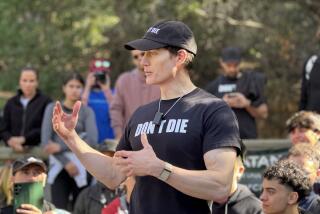Op-Ed: I lived in a truck for 6½ years. Trust me, trying to roust homeless from their vehicles is no solution
- Share via
The recent crackdown in Los Angeles on people living in their cars and recreational vehicles got me remembering what it was like to be homeless. I lived out of my truck for 6½ years from 2002 through 2008.
There is no easy solution to homelessness, but criminalizing it isn’t the answer. That’s essentially what L.A.’s new ban does: It prohibits parking “for habitation purposes” in residential neighborhoods and bumps the homeless to commercial and industrial streets, many of which have parking restrictions or meters.
I feel for those people. I marvel that I survived something similar and finally got out of it.
I was lucky. I never pushed a shopping cart, had mental or drug problems, begged for money or stayed in a homeless shelter. I had an old pickup with a camper shell to sleep in and a little income, but not enough to rent an apartment. I mostly paid to stay at county, state and federal campgrounds in the desert and at the beach in Southern California, and in cooler northern states in the summers.
When campgrounds didn’t have showers, I had to make do with bathrooms in shopping malls and fast-food restaurants.
During the day, I went into town to use library computers to get work doing freelance writing assignments for newspapers and corporations. My clients had no idea I was homeless.
One challenge was finding places to clean up. When campgrounds didn’t have showers, I had to make do with bathrooms in shopping malls and fast-food restaurants, where I usually ate dollar sandwich deals.
Once I qualified for early Social Security in 2005, at age 62, my plight eased somewhat. I was already on waiting lists for government-subsidized apartments, but it took years due to the demand.
Building more permanent housing for the homeless, as L.A. plans to do with the proceeds of its recent $1.2-billion bond issue, is a crucial but long-term solution. Homelessness is an immediate problem.
Shelters help. Some businesses allow overnight RV and car stays in their parking lots. In Santa Barbara, a nonprofit runs a program for the city that includes “case management” with an overnight-only parking spot in certain lots, which revert to their regular uses every morning. More cities need such programs.
Chula Vista, San Francisco, Santa Rosa, Sacramento and others have an answer for the bathroom problem too. They set up mobile showers and toilets, some with washers and driers for the homeless. That’s a lot better than trying to wash your hair in a bathroom sink at a fast-food place.
I thought my homeless days were over in December 2008, when I finally got a subsidized apartment in Rancho Mirage, and then in Palm Desert. However, in the summer of 2014, I took a chance, put my stuff in storage and gave up my apartment in order to look into moving back to my home state of Montana. I couldn’t afford both the rent and the trip.
In Missoula, Mont., I was en route to a Forest Service campground, but it was late so I checked out a Walmart parking lot where RV and car camping was allowed. I went into the store. When I came out, two men running with loaded shopping carts stopped me and one slugged me several times in the chest. A third came up from behind, put my head in an armlock and pounded my right eye. I was permanently blinded. The police told me the trio had been on a shoplifting spree. All three eventually pleaded guilty; the one who blinded me was sentenced to 20 years in prison with five years suspended.
It took the monetary help of friends and strangers for me to recuperate in a motel after eye surgery and then return to Southern California. After three more months of cheap-motel living I found another subsidized senior apartment. Now I hope my homeless days are behind me forever, but I know nothing is certain in life or the economy.
A year ago Christmas, the priest at my church in Palm Desert gave me $100 to give out to homeless people as I wished. I broke it down into $10 bills. I didn’t have any trouble on Christmas Day finding men and women in need outside fast food restaurants, resting at a bus stop, pushing a shopping cart down a sidewalk and in a parking lot at a Walmart.
I had already decided the money should go to the first 10 homeless people I saw: no judgments. It wouldn’t matter if they were drunk, on drugs, able to work, whatever. Their eyes all lit up. They got a $10 bill, so much better than a buck, and it made me feel good.
Try it sometime, maybe with the next homeless person you see pushing a shopping cart — or sleeping in a vehicle on your block.
Les Gapay is a retired journalist in Southern California.
Follow the Opinion section on Twitter @latimesopinion and Facebook
MORE FROM OPINION
Kremlingate: What did President Trump know and when did he know it?
Democrats are copying Republican obstruction tactics. This won’t end well for the U.S.
Trump just casually demolished the two-state solution to the Israeli-Palestinian conflict
More to Read
A cure for the common opinion
Get thought-provoking perspectives with our weekly newsletter.
You may occasionally receive promotional content from the Los Angeles Times.










